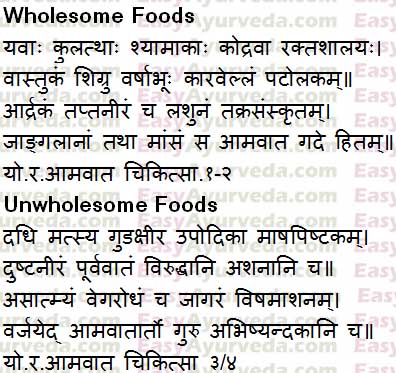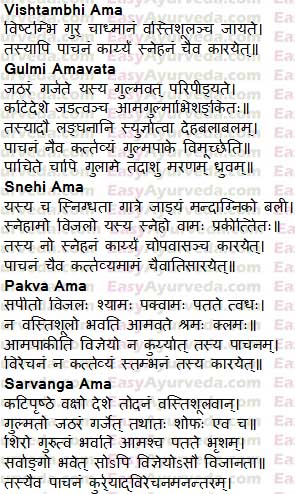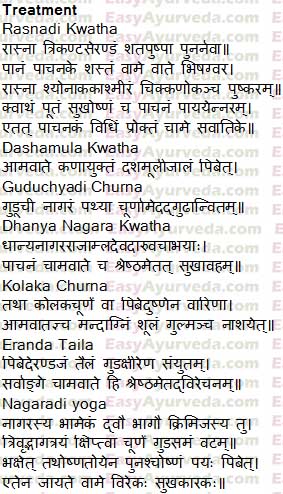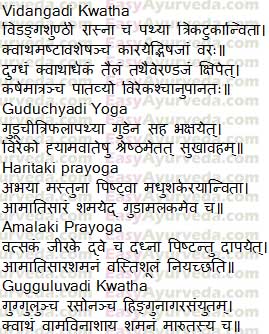Amavata: Causes, Pathology, Treatment, Panchakarma, Medicines
Article by Dr Raghuram YS BAMS, MD (Ay)
Amavata is a painful condition which has been explained in Ayurvedic texts. The disease initially manifests as a gut disorder with symptoms of indigestion and anorexia. Later the disease is seen to encroach all the tissues, mainly bones, muscles and joints and multiple organs to cause a symptom complex. This condition is often compared to Rheumatoid arthritis of modern day. Some authors have also compared it to stages of gouty arthritis.
The disease is formed due to vicious amalgamation of morbid Vata and ama.
Ama – is the immature nutritional essence formed in the stomach due to sluggish digestion (agnimandhya and ajeerna). This essence goes into circulation in immature and unprocessed form. It is made available to all the tissues and organs of the body. Since it is immature, the tissues can take it but cannot metabolize it due to lack of identification. They are therefore stored in the cells and are neither digested nor flushed out. Owing to their sticky nature ama blocks and clogs all the channels of nutrition in the body. This depletes the nutrition and essential materials to the tissues and organs. As a result there is multiple tissue damage and wide array of diseases are manifested.
Table of Contents
Causes
- Viruddha ahara – mutually incompatible foods
- Viruddha chesta – unwholesome lifestyle practices
- Mandagni – having low metabolism and sluggish digestion for a longer period
- Nischala – sedentary life activities
- Snigdha bhojana, vyayama – consuming unctuous, oily and high caloric food and immediately getting indulged in exercises
Pathogenesis
How is amavata formed?
Due to the above said causes plenty of ama is formed in the body. The vata also gets vitiated and pushes the ama into different parts of the body through circulation. Mainly Vayu pushes the ama into the shleshma sthana (sites of kapha), mainly the bony joints and muscles. The ama on further vitiation by vata and kapha enters the circulation and later gets associated with morbid pitta. This gives the combination a corrosive nature and they tend to destroy any tissue or organ with which they come into contact. The vitiated ama and vata get lodged in various joints, mainly in the low back, pelvis and hips and causes stiffness of the body along with severe pain.
Symptoms
Initially the symptoms appear like those of indigestion. In this condition, the disease process has just begun and the morbidity has not reached the joints. These symptoms are:
- Angamarda – pain in body parts, general body ache
- Aruchi – anorexia, tastelessness
- Trishna – thirst
- Alasya – lethargy, weakness
- Gaurava – heaviness of the body
- Jwara – fever
- Apaka – indigestion
- Shunata – swelling of body parts
In the later stages when the disease spreads to the joints, tissues and organs the symptoms of multiple tissue and organ damage occur. They are:
- Saruja shopha – painful swelling in the joints of hasta (hand), pada (foot), shira (head and neck), gulpha (ankle), trika (sacrum and coccygeal), janu (knee), uru (thigh, i.e. hip)
- Vrishika damshavat peeda – pain mimicking that of a scorpion sting
- Agni dourbalya – sluggish digestion
- Praseka – excessive salivation, nausea
- Aruchi – tastelessness, anorexia
- Gouravam – heaviness of the body
- Utsaha hani – lack of enthusiasm
- Vairasyam – feeling of perverted and abnormal tastes in the mouth
- Daaha – burning sensation
- Bahumutrata – excessive urination
- Grahani dosha – contamination of intestines
- Apakwa mala – stools comprise of indigested food
- Kukshi kathinata – hardness of abdomen
- Shulam – colic
- Nidra viparyaya – sleep disturbances
- Trishna – thirst
- Chardi – vomiting
- Bhrama – giddiness
- Murcha – fainting
- Hrid graham – feeling of tightness of chest
- Antra kujana – gurgling sounds in the abdomen
- Anaha – flatulence
Treatment
Basic principles of treatment of Amavata
- Langhana – fasting
- Swedana – fomentation, sweating treatment, steaming, sudation
- Tikta, katu deepana – digestion promoting medicines having bitter and pungent tastes
- Virechana – purgation
- Vasti – enemas
External treatments –
- Abyanga – massage
- Swedana – steaming treatments
- Pinda sweda – bolus fomentation especially churna pinda sweda (medicated powder bolus), Patra pinda sweda (leaf bolus) and Valuka sweda (sand bolus)
- Dhara – stream pouring of medicated liquids, mainly dhanyamla dhara (fermented herbal liquids)
- Upanaha – poultices
Classical formulations
Shuntyadi Kwatha – decoction of shunti (ginger) and gokshura (Tribulus terrestris)
Shatyadi kwatha – decoction of shati (Hedychium spicatium), shunti (ginger), haritaki (Terminalia chebula), vacha (Acorus calamus), devadaru (Cedrus deodara), Ativisha (Aconitum heterophyllum), Guduchi (Tinospora cordifolia)
Pippalyadi Kwatha – decoction of Pippali (long pepper), pippalimula (root of long pepper), chavya (Piper retrofractum), chitraka (Plumbago zeylanica) and Shunti (ginger)
Dashamula Kashayam – decoction of 10 roots mixed with eranda taila (castor oil)
Shunti-guduchi kwatha – decoction of shunti (ginger) and guduchi (Tinospora cordifolia)
Shunti-guda – Powder of shunti (ginger) taken with powder of guda (jaggery)
Bhallatakadi churna – powder of bhallataka (Semecarpus anacardium), tila (sesame) and haritaki (Terminalia chebula) with guda (jaggery)
Panchasama churna – powder of shunti (ginger), haritaki (Terminalia chebula), Pippali (long pepper), trivrit (Operculina turpethum) and Saindhava lavana (rock salt)
Phalatrikadi churna – powder of amalaki (Emblica officinalis), Haritaki (Terminalia chebula), bibhitaki (Terminalia bellirica) and shunti (ginger)
Hingwadi churna – powder of hingu (asafoetida), chavya (Piper retrofractum), vida lavana (bida salt), shunti (ginger), pippali (long pepper), jeeraka (cumin) and pushkara mula (Inula racemosa)
Nagara churna – powder of nagara or ginger taken with kanji (fermented herbal drink)
Panchakola churna – powder of Pippali (long pepper), pippalimula (root of long pepper), chavya (Piper retrofractum), chitraka (Plumbago zeylanica) and Shunti (ginger) taken with hot water
Eranda Beeja – the payasa (sweetened milk recipe) prepared from purified eranda beeja (seeds of castor plant)
Erandabeejadi yoga – the pulp of seeds of eranda beeja (castor seeds) mixed with shunti churna (powder of dry ginger) and sharkara (sugar) mixed together should be taken early in the morning.
External applications:
Shatapushpadi lepa – paste of shatapushpa (dill seeds), vacha (Acorus calamus), shunti (ginger), gokshura (Tribulus terrestris), varuna (Crataeva nurvula), devadaru (Cedrus deodara), punarnava (Boerhavia diffusa), kachura (Curcuma zedoaria), mundi (Sphaeranthus indicus), prasarini (Paederia foetida) and madana phala (Randia dumetorum)
Sanskrit verses

Diet
Pathya – wholesome foods in Amavata
Barley – Hordeum vulgare
Horse gram – Dolichos biflorus
Red Rice – Oryza sativa
Shyamaka – Setaria italica / Echinochloa esculenta – Barnyard millet
Kodrava – Paspalum scrobiculatum – Kodo millet / ditch millet / rice grass / cow grass / Indian paspalum
Drumstick – Moringa oliefera
Pointed gourd – Trichosanthes dioica
Bitter gourd – Momordica charantia
Ginger – Zingiber officinale
Punarnava – Boerhavia diffusa
Hot water
Garlic processed in buttermilk
Meat of animals living in desert like regions
Apathya – unwholesome foods in Amavata
Curds
Fish
jaggery
Milk
Upodika – Basella alba – Malabar spinach
Flour prepared from black gram
Contaminated water
Wind blowing from the East
Wrong food combination
Unconducive foods
Forcibly controlling the natural body urges
Habit of keeping awake throughout the night
Irregular eating habits
Foods which are heavy to digest
Foods which cause blockage in the tissues and channels of the body
Concept Of Amavata From Harita Samhita
Master Harita has explained the types of Amavata in a different way in comparison to the other authors. Harita’s contribution towards types of amavata and differential understanding of the same might give a new perspective and open up new lights towards planning effective interventions to combat this disease.
Ref – Harita Samhita, Tritiya Sthana (3rd section), chapter 22, Amavata Chikitsa (treatment of amavata)
Types of Amavata
1. Vishtambhi Ama
Symptoms –
- Sharira guruta – heaviness of the body
- Adhmana – distension of the abdomen
- Vasti Shula – pain in the region of urinary bladder
Treatment
- Pachana – ama digesting medicines and measures
- Snehana – unctuous measures
2. Gulmi Amavata
- Jatara garjana – gurgling sounds in the abdomen
- Gulmavat Paripidyate – pain as in abdominal tumors
- Kati deshe jadatvam – stiffness in the pelvic region
Treatment
- Langhana – initially body lightening measures like fasting etc should be done after having thoroughly analyzed the strength and weaknesses of the patient
- Pachanam naiva kartavyam – ama digesting measures should not be adapted in this condition because the condition regresses immediately after the gulam gets digested / matured. If pachana is given in this condition, it will cause immediate death of the patient.
3. Snehi Ama
- Gatra Snigdhata – oiliness of the body
- Jadhya – stiffness of body parts
- Mandagni – low digestive fire
- Snigdha-vijala ama – excretion of oily ama devoid of wetness (water)
Treatment
- Na snehanam karyam – all unctuous measures shall be avoided
- Upavasam cha karayet – fasting and consumption of less and light foods should be advocated
- Pachana – ama digesting medicines and measures should be adapted
- Amam cha eva atisarayet – excessive ama in the body should be purged out of the body
4. Pakva Ama
- Pita vijala shyava pakwa ama patate adhah – excretion of ama which is yellow or brown in color, devoid of wetness due to absence of water and digested i.e. well formed
- Na vasti shula – absence of pain in the region of urinary bladder
- Shrama –exhaustion
- Klama – languor
Treatment
- Na kuryat tasya pachanam – In this condition the digestion of ama has already occurred. Therefore measures which tend to digest the ama should not be administered.
- Virechanam na kartavyam – purgation should not be given in this condition because there is already downward flow of digested ama.
- Stambhanam tasya karayet – constipating medicines and measures should be adapted.
5. Sarvanga Ama
- Kati prushte vaksho deshe todanam – pricking pain in pelvis / low back, back, and chest
- Vastishula – pain in the region of urinary bladder
- Gulmato jatharam garjate – gurgling sounds in the abdomen as in abdominal tumors
- Shopha – swelling / inflammation of body parts
- Shiro gurutvam – heaviness of the head
- Amascha patati – excretion of ama
Treatment
- Pachana – ama digesting medicines and measures should be adapted followed by
- Virechana – therapeutic purgation
Prognosis
Vishtambhi ama, Gulmi ama and Sarvanga ama are easily curable whereas Snehi and Pakva ama are curable with difficulty.
Sanskrit Verses



Treatment
Pachana Vidhi – medicines for digesting ama
1. Rasnadi Kwatha 1
The decoction prepared with the below mentioned ingredients digests ama in amavata –
- Rasna – Pluchea lanceolata
- Trikantaka – Tribulus terrestris
- Eranda – Ricinus communis
- Shatapushpa – Anethum graveolens
- Punarnava – Boerhavia diffusa
2. Rasnadi Kwatham 2
Decoction prepared with the below mentioned herbs shall be used to digest ama –
- Rasna – Pluchea lanceolata
- Shyonaka – Oroxylum indicum
- Kashmarya – Gmelina arborea
- Chikkana – Centipeda minima
- Pushkaram – Inula racemosa
Useful formulations
The below mentioned formulations are useful in digesting the ama in amavata and also to relieve its symptoms.
Dashamula Kwatha
Decoction prepared with ten roots taken with powder of long pepper.
Guduchyadi Churna
Powder of the below mentioned are mixed with jaggery and consumed –
- Guduchi – Tinospora cordifolia
- Ginger – Zingiber officinale
- Pathya – Terminalia chebula
Dhanya Nagara Kwatha
The decoction prepared with below mentioned herbs –
- Coriander – Coriandrum sattivum
- Ginger – Zingiber officinale
- Rajamla – Rumex vesicarius
- Devadaru – Cedrus deodara
- Vacha – Acorus calamus
- Abhaya – Terminalia chebula
Kolaka Churna
Powder of Alangium salvifolium should be taken with hot water. It is said to cure rheumatoid arthritis, abdominal tumors, colic and weak digestion. Elsewhere, Kolaka is also said to be Piper cubeba.
Eranda Taila
Castor oil should be consumed with hot milk mixed with jaggery. This is said to be the best purgative and highly praised medicine for ama / amavata present in entire body.
Nagaradi yoga
Tablets prepared with below mentioned herbs and consumed with hot water. Following this, patient should drink hot milk.
- Ginger– Zingiber officinale – 1 part
- Krimija – Aquilaria agallocha – 2 parts
- Trivrit – Operculina turpethum – 3 parts
- Jaggery – 6 parts
This formulation not only expels ama from the body and cures amavata, but is also a useful purgative.
Vidangadi Kwatha
Decoction prepared with below mentioned herbs
- Vidanga – Embelia ribes
- Ginger- Zingiber officinale
- Rasna – Pluchea lanceolata
- Pathya – Terminalia chebula
- Trikatu – powder of long pepper, black pepper and ginger
This decoction should be mixed with half the quantity of milk and castor oil. This formulation is a good purgative.
Guduchyadi Yoga
Powder of below mentioned herbs when taken with jaggery, act as purgative.
- Guduchi – Tinospora cordifolia
- Triphala – fruits of Terminalia chebula, Terminalia bellirica and Emblica officinalis
- Pathya – Terminalia chebula
Yogas from Sahasra Yoga Text book
- Maharasnadi kwatha
- Amruta Guggulu
- Yogaraja guggulu
- Amavatari rasa
Upashamana (palliative treatment)
Terminalia chebula ground with Mastu i.e. watery part of the curds / whey and consumed mixing with honey and sugar. This cures amatisara i.e. diarrhea caused due to ama, especially that which is associated with amavata.
Amalaki Prayoga
Powder of Emblica officinalis taken with jaggery has similar benefits as above mentioned formulation.
Vatsakad Yoga
Seeds of Holarrhena antidysenterica, cumin seeds and Carum carvii ground with curds and consumed. This formulation will cure diarrhea caused due to ama and pain in the region of urinary bladder associated with amavata.
Gugguluvadi Kwatha
Decoction prepared with –
- Guggulu – Commiphora mukul
- Garlic – Alium sativum
- Hingu – Asafetida
- Ginger
Ajamodadi Churnam
Powder of –
- Ajamoda – Trachyspermum ammi
- Ugragandha – Acorus calamus
- Kushta – Saussurea lappa
- Trikatu – powder of Piper longum, Piper nigrum and Zingiber officinale
- Shati – Curcuma zedoaria
- Triphala – fruits of Terminalia chebula, Terminalia bellirica and Emblica officinalis
- Bharangi – Clerodendrum serratum
- Pushkara – Inula racemosa
- Eight types of salt
- Cumin – Cuminum cyminum
- Black cumin – Carum carvii
- Vidanga – Embelia ribes
- Tumburu dwaya – Zanthoxylum alatum & Avicennia officinalis
- Daru – Cedrus deodara
- Bilwa – Aegle marmelos
- Shilabheda – Bergenia ligulata
- Rodhra – Symplocos racemosa
- Vatsaka – Holarrhena antidysenterica
- Vasa – Adhatoda vasica
- Flowers of Woodfordia fruticosa
- Bark of Salmalia malabarica
- Pomegranate
Benefits of Ajamodadi Churna
This powder bestows many benefits depending on the vehicle it is used with.
- With ghee it cures vata disorders
- With asafetida and aranala i.e. fermented medicinal liquid it cures colic and pains
- With hot water cures rheumatoid arthritis
- With decoction of dashamula i.e. ten roots, it cures sciatica and low back pain
- With castor oil, it cures constipation and severe swelling
- With urine of cow it cures abdominal tumors
- With jaggery it cures anemia and liver disorders
- With honey it cures diabetes mellitus
- With sugar, it cures tuberculosis, wasting and tissue loss
When skillfully used by the physician along with suitable vehicles, this powder effectively cures all the diseases.
Contraindications in Amavat
- Cold water bath
- Too hot foods and drinks
Indications
All beneficial diets mentioned in context of ‘treatment of fever’ is beneficial in amavata.
Etiological factors
- Being nourished by foods and eatables which are heavy to digest
- Weak digestion power
- Indulgence in excessive sex
- Tarpitaih kanda shakeshu – getting nourished by tubers and green leafy vegetables / vegetables.
Pathogenesis
Consumption of above said etiological factors in excess, cause ama and vitiated vata mix up with each other. Both these ama and vata reach the seats of kapha and produce severe pain. This condition is called as amavata.
Symptoms
- Bahu vedana – Severe pain and different kinds of pain in body parts
- Amatisara – diarrhea along with ama, unformed stools
- Sandhi shopha – swelling in the joints
- Jaratwam gatranam – weakening of the body parts, the patient feels as if his body parts have become old and worn out
- Balasa patanam mukhe – expectoration of phlegm from the mouth
- Prushta manya trika vedana – pain in back, nape of the neck and pelvic region
- Anga vaikalya – physical deformities









